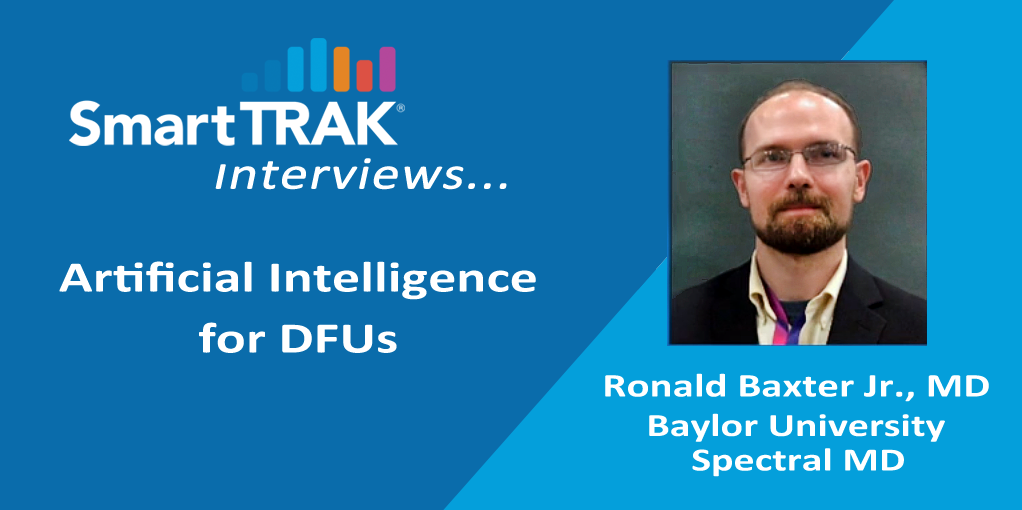 Dr. Ronald Baxter of Baylor University and Spectral MD, discusses the Spectral MD DeepView Wound Imaging System in predicting DFU wound healing utilizing artificial intelligence in an interview with SmartTRAK.
Dr. Ronald Baxter of Baylor University and Spectral MD, discusses the Spectral MD DeepView Wound Imaging System in predicting DFU wound healing utilizing artificial intelligence in an interview with SmartTRAK.
Spectral MD has developed the DeepView Wound Imaging System to utilize real-time data and artificial intelligence to predict wound healing. The Company has seen initial success in burn treatment and is now moving into validation of their system for diabetic foot ulcers (DFUs) with the goal to predict a wound’s healing potential at the initial clinical visit.
To learn more about Spectral MD’s multi-spectral imaging system, DeepView; the pilot DFU study to analyze the predictive qualities of its artificial intelligence deep learning program, and the company’s plans moving forward; SmartTRAK interviewed Dr. Ronald Baxter, of Baylor University and Spectral MD.
A transcript of SmartTRAK’s interview with Dr. Baxter is below. To view the interview recorded live at SAWC Spring 2019, click on the following video.
Susan Paquette: Hi. I'm here at the SAWC poster session with Dr. Ronald Baxter from Baylor University. He's presenting some information here, data, on diabetic foot ulcers and artificial intelligence. Dr. Baxter, can you tell me a little bit more about what you've got here?
Ronald Baxter: I can. Thank you, Susan. I'm Dr. Baxter. I'm actually a surgery resident, currently at Baylor University Medical Center in Dallas. I'm working for Spectral MD in my years off of research. I have a Bachelor's of Science in biomedical engineering, so it was very attractive to me and the reason I'm working here.
One of my jobs at Spectral MD was to design a clinical study around clinical useful wound care. We have a device at Spectral MD and it's called the DeepView device that has already been studied in burn care and supported by various government agencies such as the BOD and BARDA, to study burn care and burn treatment. My goal was to expand this technology to DFU care and to amputation care, something that could make a larger impact on the wound community as a whole.
On this poster, in this clinical study, we aim to use our device which is a multi spectral imaging device. It measures eight different specific wavelengths that are tethered to specific tissue characteristics, such as deoxygenated hemoglobin, oxygenated hemoglobin, tissue edema, tissue damage, collagen damage, and use those eight wavelengths, put them into an artificial intelligence algorithm, as well as some medical comorbidities, patient age, and some other clinical data. We run that data through the algorithm, and then end up with a result.
In this case, we're trying to keep it simple since this is preliminary studies and our results are healing and non-healing DFUs at 30 days. In the clinical study design, we would have patients come in at day zero to the wound care clinic. Using this device right here, called the DeepView device, we would image the patient's DFU just once. It would take about 20 seconds to acquire the multi spectral imaging data. Then after that, over the next 30 days, that patient would undergo standard routine care of the DFU which could tell anything from minimal debridement, routine dressing changes, anything the podiatrist or wound care physician wants to do.
After that 30 days, plus or minus five, we would acquire a digital image of the wound shown here. This is an example of a digital image at day 30. Compare that image to the image at day zero and then make something called a ground truth image. The yellow here is whatever portion of the wound that did not heal by day 30. We use these images, as shown here in this example, to train the artificial intelligence program. Because initially, when using the AI, the DeepView device takes a picture of the DFU, the prediction result is a blue area shown here in these DFUs of what we want to be non healing tissue at 30 days. A prediction of the future.
But currently, since we're still training the algorithm, we need to teach it. We use these yellow areas of non healing ground truth images to teach the algorithm. After this initial preliminary study of eight DFUs, we have results shown here. We trained a few different algorithms, but the best algorithm was when we piggybacked this study off of another study with burn wounds that we did before for a total of 66 wounds. That was 58 burns, and then the eight DFUs. We had an accuracy of 98%, essentially which means that 98% of the pixels that said it was either healing or non healing was right. The metrics that clinicians are more familiar with got a very high sensitivity of 98% and specificity of 94%, which is really good for a screening test.
Our studies continue. This study actually is continuing and we have an NIH grant at the NIH. It's been evaluated by NIDDK as well as some other branches of the NIH. After that, we will have a clinical study number for you to reference. Later, we'll have more data as we acquire more DFUs.
Susan Paquette: So how many patients are you hoping to enroll in your clinical study?
Ronald Baxter: Currently, the goal is about 125 patients. We have been very impressed with the results so far with just eight. Again, we are piggybacking off of our other algorithm for wounds. As the study grows in number, and if we are happy with the accuracy (we haven't defined a number to make us happy yet) but if we are, we may cut the study short. The goal after this is to expand to multiple sites even to find some way to have this device used in clinics maybe by wound care physicians, podiatrists, primary care physicians, and maybe all of them. Widespread across the country, maybe even the world to guide DFU treatment.
Susan Paquette: Very good. Thank you.
Ronald Baxter: You're welcome. Thank you.
_______________________________________________
If you're planning on attending EWMA in Sweden next week (or even if you're not) check out SmartTRAK's Top Ten Things To Do in Gothenburg Sweden While at EWMA.




.png)
